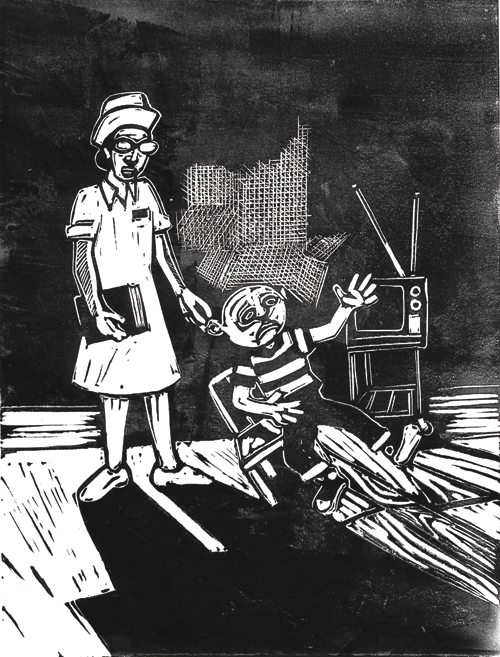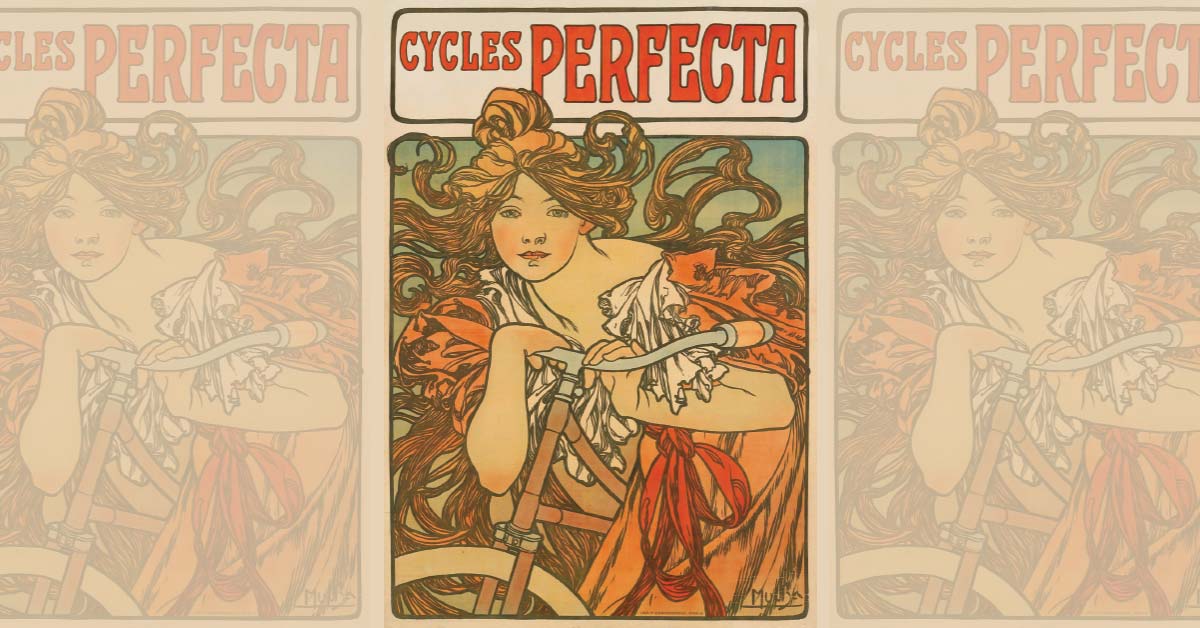A Detroit artist’s narrative linocuts, a composer’s four-screen video supercut, an Andy Warhol showcase — the Grand Rapids Art Museum’s three exhibits opening this month don’t have much in common, except that each is sure to offer something you haven’t seen before.
Walking into the GRAM, the first art you’ll see is Carl Wilson’s large linocut prints, which run along the wall beneath the second-floor balcony. This is just an introduction to the Detroit artist’s full exhibition, Her Purse Smelled Like Juicy Fruit and Other Tales, which also makes for his first-ever solo museum show.
Wilson primarily works with stark black-and-white linocuts, a process that involves etching into a sheet of linoleum to create a kind of stamp. With those images, Wilson often includes text, creating series akin to graphic novels.
“He has a really unique and interesting voice — that’s what I think people will like,” said GRAM Chief Curator Ron Platt. “He’s a great storyteller with a real command of language.”
While the large-scale pieces are about Wilson’s time as an autoworker, Her Purse Smelled Like Juicy Fruit takes a look at the life of his mother as he tries to understand her from an adult perspective.
“I think he created this to get to know her better, because he always felt like she was a sort of monolithic presence in his life and somewhat mysterious,” Platt said. “Everybody has an interesting story, it’s just that not everybody has an artist with an eye for detail and a grasp on language to bring their narrative to life.”
The museum’s second exhibition opening this month is far from linocuts and far from narrative. Instead, Christian Marclay’s Video Quartet is wide-ranging and constantly shifting, made up of more than 700 carefully rearranged film clips. Marclay took most of these clips from recognizable Hollywood classics, featuring icons like Marilyn Monroe, Harpo Marx and Bugs Bunny. He then cut the films up and created one large piece made of four separate videos running side-by-side.
“What you see and hear are the actual movie clips and the accompanying sound,” Platt said. “He’s created a whole different musical composition. All of the clips have footage of people singing or playing instruments or making sounds in some way or another, whether they’re tap-dancing or screaming or dribbling a basketball. It’s really quite something. “
Platt said the piece takes familiar moments and recontextualizes them, creating a whole new experience. There is a delight in wondering what the next series of clips will be and how Marclay will weave them together.
At one point, you’ll see four different harp players performing four different songs simultaneously. The next moment, Marclay might take a more varied approach, combining a fiddle, guitar, piano and opera singer, for instance. Even though the piece is 17 minutes long, the clips change very quickly, creating a mesmerizing experience.
Platt believes the unusual nature of Video Quartet is exactly what people will like about it.
“Until you see this, you can say, ‘I’ve never seen anything like this before,’” Platt said. “I love the idea of showing people things they didn’t know they liked. It helps people understand that art doesn’t really respect traditional boundaries and categories.”
Marclay has made a career of innovating visually and musically. In the ’70s, he began using turntables to create sound collages before just about anyone. He also is known for physically cutting up and reassembling different LPs to create a new record that quickly jumps back and forth between songs.
All in all, Platt believes Video Quartet will provide a memorable experience for anyone.
“It’s just remarkable the journey he takes you on,” he said. “Sometimes, the most exciting and entertaining things can have a lot of meaning and depth to them. We’re sort of bringing all that together with this one. It’s a very exciting piece for a museum to share with its audience.”
The final exhibition, Andy Warhol’s American Icons, will be more familiar to most visitors, focusing specifically on the 20th century pop artist’s ability to both capture and create culture.
“(Warhol) was somebody that really surveyed American culture and was in some ways just amazingly prescient,” Platt said. “People with money commissioned him to make portraits of them, so it’s the way he sort of constructed icons as well.”
The exhibition includes paintings, prints, photographs and films — including an eight-hour long video “portrait” of the Empire State Building — from the artist, along with some space dedicated to silk-screen printmaking, which Warhol innovated as an artform.
Platt wants to use the exhibition to dig deeper and go beyond what most people already know about the artist.
“People will come and see something that’s familiar to them, but hopefully leave with a little bit of a deeper understanding of what motivated Warhol and what he was interested in,” Platt said.
Grand Rapids Art Museum
101 Monroe Center St. NW, Grand Rapids
artmuseumgr.org, (616) 831-1000
Christian Marclay: Video Quartet
Oct. 28-Jan. 14
Andy Warhol’s American Icons
Oct. 28-Feb. 11
Carl Wilson: Her Purse Smelled Like Juicy Fruit and Other Tales
Nov. 3-Feb. 11





